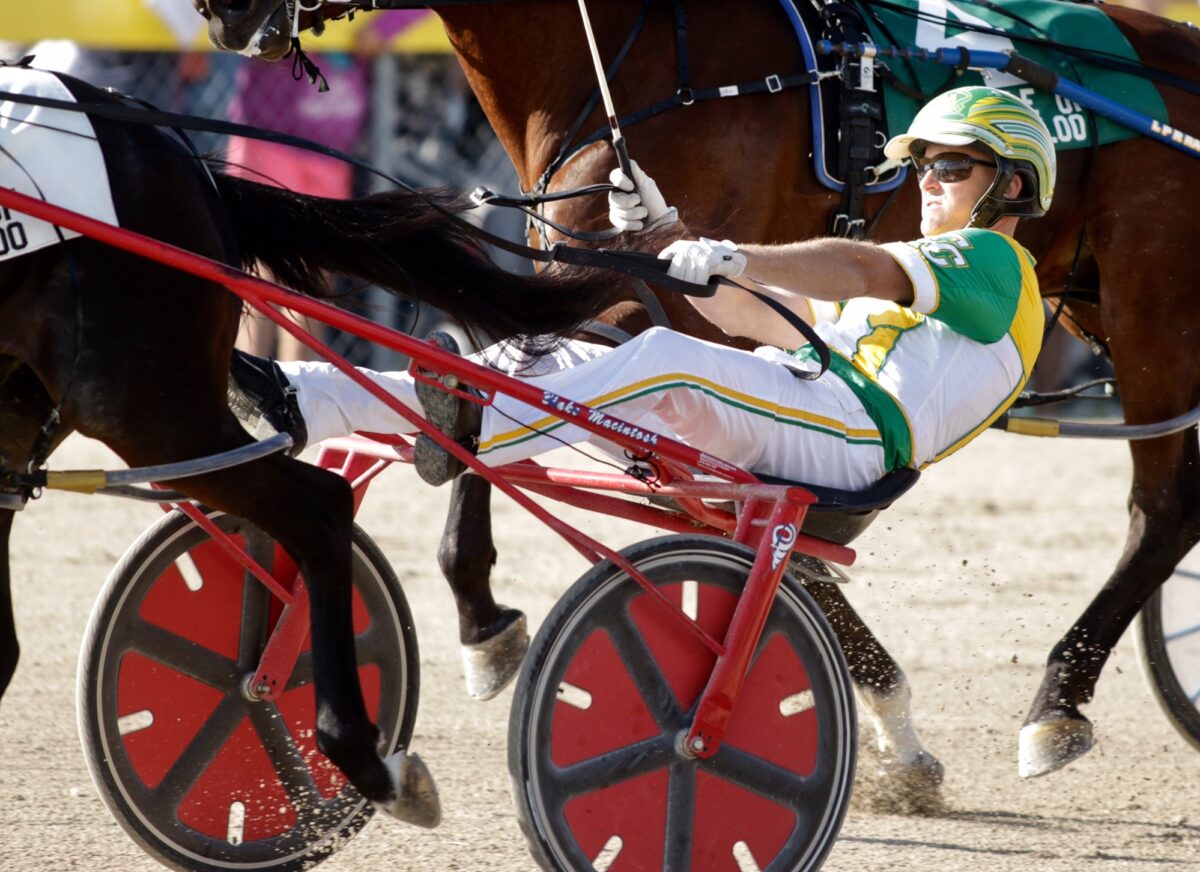Harness racing was Corey Callahan’s escape from the 9-to-5 grind
by Murray Brown
Although Corey Callahan was figuratively born into harness racing, it wasn’t until he reached adulthood that he realized that his future rested with the sport. He is the son of long time Eastern Shore trainer Nick Callahan. Growing up, Corey was always around horses but he was far more interested in other sports, mostly hockey and soccer. It was hockey which brought him to Lexington, KY, and the University of Kentucky. But even that immersion in what some might consider to be the world capital of horsedom did not lead to his becoming a full-time horseman, more specifically a full-time driver of harness horses. In fact, it played almost no part in it.
“My parents did not particularly want me to get into harness racing,” Corey said. “My dad wanted me to get a good education then to make my way in the world as I saw fit.
“I was a pretty good athlete. I was all state in soccer and was a fairly decent hockey player. I decided against soccer because it often results in so many lower body injuries. I was originally planning to go to Villanova which had a division two hockey program. However, due to the intricacies of NCAA sports, its hockey program was cancelled. Kentucky had been my second choice, so that is where I went.
“I spent four great years there and graduated with a degree in Business Administration. From there I entered the business world where I worked for recruiting firms specializing in business and finance. I worked at that for a couple of years, but soon tired of what I perceived as the nine-to-five drag and the boredom associated with it. I called my dad and asked him for a job. I had never previously been much involved with the horses. I soon found that I enjoyed being around and working with them.”
At that point, you were in the midst of becoming a full-time horseperson?
“I suppose so. Dad bought a couple of cheap horses that we would own together with which I could learn the trade and with which I could ‘practice.’ This was in 2005. I joined an amateur driving club where I would race my horses. I was fairly good I guess, but of course, that’s all relative, because the others in the club might not have been. I won my first two races and they asked me to leave because they said I was too good. I continued working for my dad and I wanted to get my professional driver’s license.
“My cousin is Frank Milby. He told me that he was going to give me my first professional win as a driver. He had this cheap mare who was competitive pacing around 2:00. He put me down to drive her at Rosecroft and she won by eight lengths in 1.57. In her next start, she was claimed. Frank was not all that happy with me.
“Then dad began putting me down to drive the horses in his stable. I continued doing reasonably well. In 2006, dad had me drive Cool Flying Fool for him at Rosecroft. He was the star of his stable. He won in 1.50.4 which at the time was the track record. I continued to do better. I started to get all sorts of catch drives, even drives in stakes races. I won eliminations of a lot of them and the finals in some.
“I loved it!! Every day was a good day!!”
You began to branch out from being a small-track regional driver at Rosecroft to other tracks in the Northeast.
“Yes. The drives kept increasing to Dover, the Pennsylvania Tracks at Pocono Downs and Chester and to our Valhalla of racetracks, The Meadowlands.”
Do you have any favorite tracks at which you enjoy racing?
“I would answer that by saying not necessarily specific tracks, but more generally larger tracks. I’m not that crazy about racing on half-mile tracks, but having said that, just last night I was fortunate enough to win five races at Harrington, a half-mile track. I suppose the best answer is that I go where the horses I get to drive take me. I love racing at The Meadowlands and The Red Mile of course. They, together with Mohawk, represent the ultimate in North American racing. Not only are the tracks configured so that it is easier on the horses, but also, I believe that the person wagering his hard-earned money generally gets a better bang for his buck. On a half-mile track if you get away worse than fourth, you rarely have much of a chance of winning the race. Whereas on a large track you can often win from anywhere.”
You used to be a regular presence at The Meadowlands, being there for its Friday and Saturday night cards. Now you are not there near as often. Any reason why?
“There are several reasons. One of the chief ones is it’s so time consuming, driving up and down the New Jersey Turnpike on a weekend. It’s not unusual for it to take as long as almost three hours in each direction. That’s not to say that if I had enough drives on good horses to do so that I wouldn’t. The fact is that the quality of the overnight racing there has diminished. They usually have at least two and as many as four amateur races on a Friday night. This takes away from any opportunities that the professionals have to make a living. The most important factor is that I have four young children ranging in age from 5 to 13. I don’t want to be one of those fathers who one day says, ‘I wish I hadn’t missed the best years of my children’s growing up because I was too busy working.’”
Let’s speak of those children. Are any of them inclined towards the horses?
“There are four of them, two girls and two boys. The girls — Ceira, 13, and Blakely, 7 — love the horses and are quite involved with them. They both ride and are what I would consider to be quite ‘horsey.’ The boys — Jackson, 11, and Weston, 5 — like the horses, but are much more involved in other sports. I would come close to describing my wife Joanna as almost being a horse whisperer. She has an amazing relationship with them. We live on a small farm that at one time was owned by the Mazik family, who owned the great Silk Stockings. We have a few broodmares on it through which we raise some yearlings.”
You’ve driven a lot of very good horses. Are there any favorites?
“Without a doubt Googoo Gaagaa is my all-time favorite. What a great privilege it was to have been his driver. He was everything that you might look for in a racehorse. He had a great gait and was a powerful presence on the racetrack. He now appears to be on his way to becoming one of the world’s great trotting sires.
“I believe if Hollywood had any interest in harness racing, they would have the greatest imaginable story ever if they followed his career, both on the racetrack and at stud. His breeder and owner for a good part of his career, Richard Hans, is one of the greatest horsemen I have ever been around, but he is a man with very few people skills. Can you think of all the story lines that could be pursued?
1. The little guy [Richard Hans] against the entrenched majority.
2. The seemingly impossible: a horse that is bred to pace not only becoming a trotter, but also becoming a champion trotter.
3. His owner/breeder once again going against the tide by standing him at stud.
4. From very little opportunity at stud in North America having him sire a champion trotter here in the Hambletonian winner Captain Corey.
5. After turning down several opportunities to sell him overseas, his owner finally succumbs to the offers and watches him become one of the world’s great trotting sires.
“If you didn’t know it to have actually happened, you probably wouldn’t believe that it did.”


















